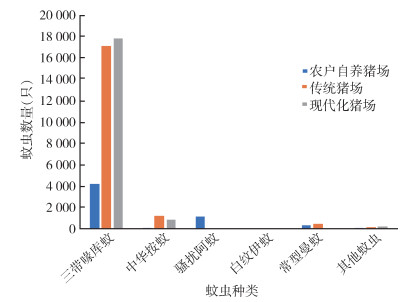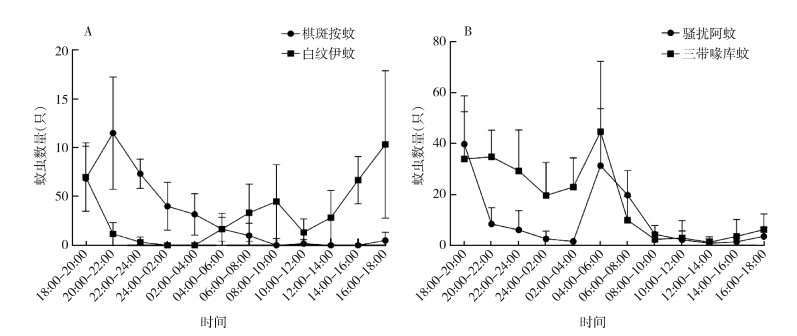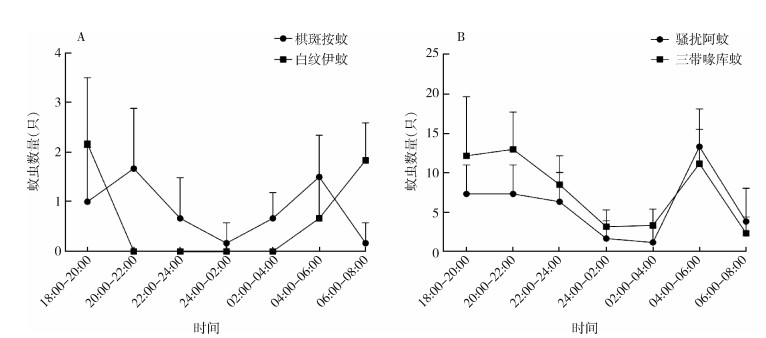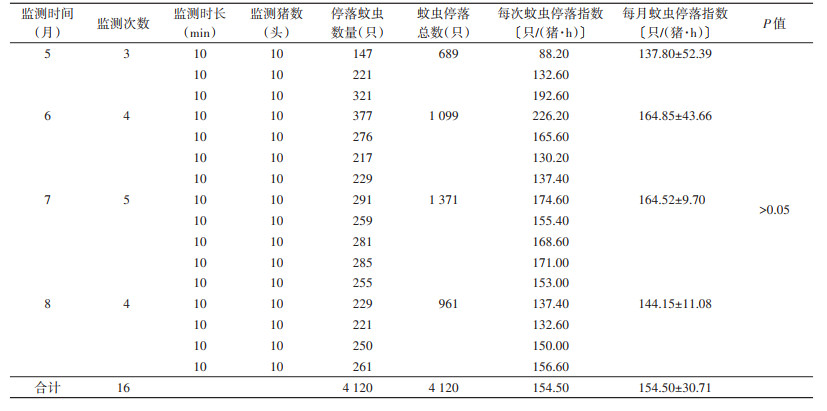
扩展功能
文章信息
- 石彦丽, 赵建国, 韩谦
- SHI Yan-li, ZHAO Jian-guo, HAN Qian
- 海南省不同模式猪场蚊虫密度及活动规律调查
- Densities and activity patterns of mosquitoes in different types of pig farms in Hainan province, China
- 中国媒介生物学及控制杂志, 2021, 32(5): 576-581
- Chin J Vector Biol & Control, 2021, 32(5): 576-581
- 10.11853/j.issn.1003.8280.2021.05.013
-
文章历史
- 收稿日期: 2021-04-06
海南省位于中国最南端,其陆地主体地理位置介于东经108°37′~111°03′,北纬18°10′~20°10′,属于热带季风气候。全岛雨水充足,气候湿润,非常适合病媒生物尤其是蚊虫的繁殖和生存。海南省中小型养猪场多位于村庄、山区和林地等自然环境中,可提供蚊虫丰富的血餐来源,因此蚊虫孳生普遍。何昌华等[1]通过对海南省城区不同生境蚊虫密度监测时发现,牲畜棚平均蚊虫密度高于居民区、医院、公园和农户等地。蚊虫叮咬不仅使猪群瘙痒难安、引起剐蹭、躁动,影响猪群生长速度;同时,使皮肤出现红疹甚至出血,增加了皮肤病的发病概率[2]。相关研究表明,蚊虫叮咬会增加猪群感染蚊媒传染病,如附红细胞体、猪流行性乙型脑炎(乙脑)等的风险[3-5],还会导致公猪睾丸炎[6]、哺乳母猪流产、死胎等[7],从而影响猪场生产效益。
海南省现有猪场模式主要有3种,分别是小型农户自养模式、半开放传统化养殖模式以及全封闭现代化养殖模式。小型农户自养模式猪群采用半开放式地栏饲养,自动饮水,人工投料;半开放传统化养殖模式实施规模化计划生产,定位栏,产床,保育猪高床设施齐全,自动饮水,人工投料,其粪便处理采用打粪包和用水冲栏方式,对环境污染较大;全封闭式现代化养殖模式采用世界先进工艺,实施负压垂直通风、刮粪板清粪、污水高级氧化等现代处理手段,全面实现投料自动化、温控自动化[8-9]。尽管已经有一些猪场蚊虫的防控产品[10-12],但由于不同生猪养殖模式及管理水平下猪场蚊虫活动规律不同,需要制定合理的防控程序。为此,本试验选取了位于儋州市那大镇铺仔村六队的小型农户自养猪场、位于屯昌县新兴镇金昌园村附近的传统猪场以及位于临高县皇桐镇富雄村的现代化猪场进行蚊虫活动监测,丰富了各类猪场蚊虫活动基础数据,为针对性开展蚊虫防控提供科学依据。
1 材料与方法 1.1 材料手持吸蚊器(购自慈溪市亚细亚卫生杀虫器械厂);宠物笼(125 cm×105 cm×95 cm),蚊帐(2.00 m×1.80 m×1.75 m);养殖场专用紫外线诱蚊灯(型号为GM950)。
1.2 方法 1.2.1 不同模式猪场蚊虫季节活动规律监测采用诱蚊灯法在上述3个猪场开展蚊虫监测工作。每处布灯2盏,布灯高度离地面约1.5 m,两灯间隔均 > 50 m,分别置于猪栏外两侧。监测周期为2020年1-12月,每月监测4次,每次间隔约为1周,遇暴雨天气顺延,从当日17:00至次日08:00进行诱捕。监测结束后,将集蚊网带回实验室,使蚊虫冷冻致死并通过显微镜进行蚊虫分类、计数。采用以下公式进行蚊虫密度计算:

|
(1) |
采用动物帐诱法和诱蚊灯法针对农户自养猪场蚊虫活动进行监测。动物帐诱法:将动物网帐罩在生猪饲养笼外,将生猪置于饲养笼内正常饲养。网帐距离地面约30 cm,便于蚊虫进入蚊帐吸血,从而诱捕蚊虫。监测周期为12 d,隔天监测,每次监测从当天18:00开始至次日18:00结束,每隔2 h用手持吸蚊器收集蚊帐内蚊虫,共计收集12次,冷冻致死并进行分类、计数。采用以下公式进行蚊虫密度计算:

|
(2) |
网帐诱捕试验结束后采用诱蚊灯法继续开展监测,将试验猪集中饲养于1个猪栏内,在距离地面1.5 m处悬挂诱蚊灯,监测周期为12 d,隔天监测,每次监测从18:00至次日08:00,每2 h换灯1次,共计换灯7次。将捕捉的蚊虫冷冻致死并分类、计数,采用公式(1)得出蚊虫密度。
1.2.3 传统化猪场蚊虫停落指数监测5-8月为海南省蚊虫活动高峰期,在该时期采用猪诱停落法对传统化猪场进行蚊虫停落监测。随机挑选靠近走廊且处于熟睡状态的10头猪,对10 min内停落在猪身上的蚊虫数量进行人工计数。监测周期为4个月,每隔1周监测1次,每次监测时间为23:00-24:00。停落指数参照中国疾病预防控制中心人诱停落法标准计算公式:

|
(3) |
利用Excel 2010和SPSS 26软件进行数据整理分析;采用χ2检验对不同生境的蚊种构成进行比较,利用单因素方差分析对蚊虫年平均密度、停落指数等进行比较,平均值表示为平均值±标准差。P < 0.05为差异有统计学意义。
2 结果 2.1 不同模式猪场主要蚊虫数量、密度及构成本次监测收集蚊虫9种共43 995只,主要蚊虫有5种,分别为三带喙库蚊(Culex tritaeniorhynchus)、棋斑按蚊(Anopheles tessellatus)、骚扰阿蚊(Armigeres subalbatus)、白纹伊蚊(Aedes albopictus)和常型曼蚊(Mansonia uniformis),此外,在3个猪场还采集到少量二带喙库蚊(Cx. bitaeniorhynchus)、致倦库蚊(Cx. pipiens quinquefasciatus)和中华按蚊(An. sinensis),在传统猪场还采集到刺扰伊蚊(Ae. vexans)。不同模式猪场主要蚊虫数量如图 1所示。农户自养猪场、传统猪场及现代化猪场采集蚊虫总数依次为5 973、19 107和18 915只。不同模式猪场主要蚊种蚊密度及构成比见表 1、2。根据监测结果,3个不同监测点的优势蚊种均为三带喙库蚊,但3个猪场三带喙库蚊密度水平及构成比不同,农户自养猪场三带喙库蚊密度为(3.37±3.73)只/(灯·h),构成比为70.33%;三带喙库蚊在传统猪场和现代猪场的密度水平分别为(13.72±15.09)和(14.24±10.71)只/(灯·h),构成比分别为89.64%和93.95%。对3个猪场蚊种构成比进行χ2检验,差异有统计学意义(χ2=8 410.558,P < 0.001)。对3个猪场蚊虫构成比进行两两比较,差异均有统计学意义,其中农户自养猪场和传统猪场之间χ2=4 075.731,P < 0.001;农户自养猪场和现代化猪场之间χ2=5 172.423,P < 0.001,传统猪场和现代化猪场之间χ2=620.579,P < 0.001。

|
| 图 1 海南省不同模式猪场2020年主要蚊种捕获数量 Figure 1 Numbers of major species of mosquitoes caught in three different types of pig farms in Hainan province, 2020 |
| |

|

|
根据监测结果,农户自养猪场的蚊虫活动如图 2A所示,1-3月、10-12月蚊虫数量均呈下降趋势,3-10月蚊虫数量总体呈上升趋势,蚊虫整体活动趋势呈单峰状,10月蚊虫数量最多;传统猪场蚊虫活动规律见图 2B,整体呈波浪式,4-9月蚊虫数量波动较大,11月蚊虫数量最多;现代化猪场蚊虫活动趋势呈双峰状,蚊虫数量高峰出现在7和9月,7月蚊虫数量最多(图 2C)。

|
| 图 2 海南省3个不同模式猪场2020年蚊虫季节消长情况 Figure 2 Seasonal fluctuations of mosquitoes in three different types of pig farms in Hainan province, 2020 |
| |
动物帐诱法和诱蚊灯法监测结果分别见图 3、4。2种监测方法捕捉到的主要蚊虫种类均为棋斑按蚊、白纹伊蚊、骚扰阿蚊和三带喙库蚊,不同蚊种昼夜活动规律不同。动物帐诱法监测结果显示,棋斑按蚊活动高峰为20:00-22:00,其他时间活动较弱;白纹伊蚊、骚扰阿蚊和三带喙库蚊活动规律均呈现双峰趋势,其中白纹伊蚊晨峰出现在08:00-10:00,昏峰出现在16:00-18:00;骚扰阿蚊和三带喙库蚊均在04:00-06:00出现晨峰,昏峰出现时间均在18:00-20:00。诱蚊灯法监测结果显示,4种蚊虫昼夜活动均呈早晚双高峰趋势。棋斑按蚊晨峰出现在04:00-06:00,昏峰出现在20:00-22:00;白纹伊蚊晨峰出现在06:00-08:00,昏峰出现在18:00-20:00;骚扰阿蚊晨峰出现在04:00-06:00,昏峰出现在20:00-22:00,三带喙库蚊晨峰出现在04:00-06:00,昏峰出现在18:00-22:00。

|
| 图 3 动物帐诱法监测海南省农户自养猪场2020年蚊虫昼夜活动规律 Figure 3 Diurnal and nocturnal activity pattern of mosquitoes monitored by animal-bait net trap method in the farmer's backyard pig sty in Hainan province, 2020 |
| |

|
| 图 4 诱蚊灯法监测海南省农户自养猪场2020年蚊虫昼夜活动规律 Figure 4 Diurnal and nocturnal activity pattern of mosquitoes monitored by lamp trap method in the farmer's backyard pig sty in Hainan province, 2020 |
| |
传统猪场蚊虫停落监测数据如表 3所示。在监测周期内共进行了16次蚊虫停落监测,监测隔1周开展1次,每月监测次数受天气影响有所不同。监测到的蚊虫停落总数为4 120只,平均停落指数为(154.50±30.71)只/(猪·h),以6月的蚊虫停落指数最高,达(164.85±43.66)只/(猪·h)。经方差分析,4个监测月监测到的蚊虫停落指数之间差异无统计学意义(F=0.735,P > 0.05)。

|
本次监测结果显示,不同地点、不同养殖模式猪场中三带喙库蚊数量最多,密度最大,构成比最高,为海南省3个不同模式猪场优势蚊种。研究表明,三带喙库蚊嗜吸猪血[13],李来德等[14]2014年对新会区城区蚊种密度调查时发现,该地区野郊猪场以三带喙库蚊和致倦库蚊为优势种,可见三带喙库蚊在猪场生境中较为活跃;但也有研究表明,部分猪场优势蚊种为致倦库蚊或淡色库蚊[15-16]。三带喙库蚊是传播乙脑的重要媒介,闫秀娟等[17]对海南省西南部地区乙脑媒介三带喙库蚊季节消长和宿主动物感染情况调查时发现,海南省黄昏时优势蚊种为三带喙库蚊,占比为50.24%,其密度高达16.43只/人工小时,并且其宿主动物猪感染乙脑的比率随蚊密度增高而上升,存在乙脑传播和流行的自然环境。在本次监测中,3个猪场三带喙库蚊占比均较高,分别为70.33%、89.64%和93.95%,其蚊虫密度水平也较高,说明3种不同养殖模式猪场均存在蚊媒病流行风险,需要加强场区及周边环境的蚊虫防控工作。
据文献报道,蚊虫季节消长规律受气候影响较大,温度及降雨量是影响蚊虫活动的主要因素[18-20]。据气象资料显示,2020年儋州市6-9月出现干旱天气,10月的降雨量较大;屯昌县的降雨主要集中在10-11月,5和8月降雨也相对充沛;临高县6月降雨充沛,高温天气出现在7和9月。在本研究中,位于儋州市的农户自养猪场蚊虫活动高峰期出现在10月;位于屯昌县的传统猪场蚊虫活动在4-9月波动较大,11月为蚊虫活动高峰期;位于临高县的现代猪场蚊虫活动高峰分别在7和9月,该结果符合相关研究规律。陆年宏等[21]对东南沿海地区某演习场的蚊虫习性进行调查发现,三带喙库蚊的活动早峰为日出前的05:00,昏峰为日落后的19:00-20:00,与本研究在农户自养猪场中用2种监测方法得到的蚊虫昼夜活动规律基本一致。
综上所述,虽然3种不同模式猪场主要蚊虫种类一致,但其蚊虫季节消长规律存在差异,海南省猪场蚊媒病防控应结合自身养殖模式,根据不同模式猪场蚊虫季节消长规律特点,在蚊虫活动高峰期加强猪场环境的清理、消毒,有效控制蚊虫密度,避免蚊媒病的暴发。部分农户自养猪场可参考蚊虫昼夜活动规律,加强对猪场蚊媒病的日常防控。本研究只针对成蚊开展了监测,缺乏幼蚊监测数据,今后应将监测点转向猪场及周边环境中的幼蚊孳生地,扩大监测范围,细化监测内容,从传播源头入手,削弱猪场蚊媒传播风险。
利益冲突 无
| [1] |
何昌华, 赵伟, 王善青, 等. 海南省城区2012年蚊虫密度及季节消长分析[J]. 中国媒介生物学及控制杂志, 2014, 25(1): 15-17. He CH, Zhao W, Wang SQ, et al. Analysis of mosquito density and seasonality in urban areas of Hainan province, China in 2012[J]. Chin J Vector Biol Control, 2014, 25(1): 15-17. DOI:10.11853/j.issn.1003.4692.2014.01.004 |
| [2] |
杜明珍, 杨启明. 夏季猪场蚊虫的防治措施[J]. 中国畜禽种业, 2012, 8(11): 103-104. Du MZ, Yang QM. Mosquito control measures on pig farms in summer[J]. Chin Livest Poult Breed, 2012, 8(11): 103-104. |
| [3] |
林太明, 李圣元. 猪流行性乙型脑炎及防治[J]. 畜禽业, 2008(9): 81-82. Lin TM, Li SY. Porcine epidemic Japanese encephalitis and its control[J]. Livest Poult Indus, 2008(9): 81-82. DOI:10.3969/j.issn.1008-0414.2008.09.050 |
| [4] |
石宏伟, 王海龙. 猪流行性乙型脑炎的诊断与防控[J]. 今日畜牧兽医, 2020, 36(5): 24. Shi HW, Wang HL. Diagnosis and control of porcine epidemic Japanese encephalitis[J]. Today Anim Husbandry Vet Med, 2020, 36(5): 24. DOI:10.3969/j.issn.1673-4092.2020.05.019 |
| [5] |
任灵肖, 董壮丽, 梁剑峰, 等. 猪场防控附红细胞体效果分析[J]. 北方牧业, 2018(15): 21. Ren LX, Dong ZL, Liang JF, et al. Analysis on the effect of preventing and controlling eperythropoiesis in pig farm[J]. J North Anim Husbandry, 2018(15): 21. |
| [6] |
何子双, 王怀禹, 李彩虹. 蚊虫叮咬引起公猪睾丸炎[J]. 中国兽医杂志, 2020, 56(5): 51-52. He ZS, Wang HY, Li CH. Mosquito bites cause boar orchitis[J]. Chin J Vet Med, 2020, 56(5): 51-52. |
| [7] |
罗生. 一例猪乙型脑炎病的诊断与防治[J]. 中国动物保健, 2014, 16(2): 61-62. Luo S. Diagnosis and treatment of a case of Japanese encephalitis in pigs[J]. China Anim Health, 2014, 16(2): 61-62. DOI:10.3969/j.issn.1008-4754.2014.02.026 |
| [8] |
刘青林. 现化化猪场建设关键环节分析[J]. 饲料与畜牧: 规模养猪, 2012(5): 55-56. Liu QL. Analysis on key links of modern pig farm construction[J]. Forage Livest: Intens Pig Prod, 2012(5): 55-56. |
| [9] |
佚名. 罗牛山十万头现代化猪场建成投产[J]. 中国畜牧业, 2016(10): 28. Yi M. Luoniushan 100000 head of modern pig farm completed and put into operation[J]. China Anim Indus, 2016(10): 28. |
| [10] |
兰坚强, 任晓露, 廖承红, 等. 伊维菌素和乙基多杀菌素对埃及伊蚊作用研究[J]. 中国兽医杂志, 2016, 52(12): 7-9, 13. Lan JQ, Ren XL, Liao CH, et al. Effects of ivermectin and spinetoram on the yellow fever mosquitoes, Aedes aegypti[J]. Chin J Vet Med, 2016, 52(12): 7-9, 13. |
| [11] |
Lan JQ, Wang ZH, Chen ZH, et al. Identification of the Aedes aegypti nAChR gene family and molecular target of spinosad[J]. Pest Manag Sci, 2021, 77(4): 1633-1641. DOI:10.1002/ps.6183 |
| [12] |
Lan JQ, Zhao HW, Jin XT, et al. Development of a monoclonal antibody-based immunoaffinity chromatography and a sensitive immunoassay for detection of spinosyn A in milk, fruits, and vegetables[J]. Food Control, 2019, 95: 196-205. DOI:10.1016/j.foodcont.2018.08.002 |
| [13] |
姜义霖, 宋锋林, 李宁, 等. 大连市蚊媒调查及淡色库蚊、三带喙库蚊自然感染流行性乙型脑炎病毒研究[J]. 预防医学论坛, 2008, 14(6): 485-489. Jiang YL, Song FL, Li N, et al. Investigation on mosquitoes and study on natural infection of the encephalitis B virus of Culex pipiens pallens and Cx. tritaeniorhynchus in Dalian[J]. Prev Med Tribune, 2008, 14(6): 485-489. DOI:10.3969/j.issn.1672-9153.2008.06.002 |
| [14] |
李来德, 梁健华, 甄健斌, 等. 2014年新会区城区蚊种群密度及季节消长的研究[J]. 中国当代医药, 2015, 22(19): 161-163. Li LD, Liang JH, Zhen JB, et al. Study of population density and seasonal fluctuation of mosquito in urban area of Xinhui district in 2014[J]. China Modern Med, 2015, 22(19): 161-163. |
| [15] |
李美娣, 翁亚彪, 谭志坚, 等. 集约化猪场成蚊种群构成调查初报[J]. 养猪, 2007(5): 32. Li MD, Weng YB, Tan ZJ, et al. A preliminary report on the population composition of adult mosquitoes in intensive pig farms[J]. Swine Prod, 2007(5): 32. DOI:10.3969/j.issn.1002-1957.2007.05.014 |
| [16] |
李飞龙, 黄淑坚, 王洁希, 等. 广州从化良口镇5个猪场蚊媒介调查[J]. 国外畜牧学(猪与禽), 2019, 39(4): 68-72. Li FL, Huang SJ, Wang JX, et al. Investigation of mosquito vectors in 5 pig farms in Conghua Liangkou town, Guangzhou[J]. Anim Sci Abroad (Pigs Poult), 2019, 39(4): 68-72. DOI:10.3969/j.issn.1001-0769.2019.04.025 |
| [17] |
闫秀娟, 赵伟, 曾祥洁, 等. 海南省西南部地区流行性乙型脑炎媒介三带喙库蚊季节消长与宿主动物感染状况调查[J]. 中国媒介生物学及控制杂志, 2008, 19(5): 470-471. Yan XJ, Zhao W, Zeng XJ, et al. Investigation on the seasonal fluctuation and host animal infection of the Japanese encephalitis vector Culex tritaeniorhynchus in the southwest of Hainan province[J]. Chin J Vector Biol Control, 2008, 19(5): 470-471. DOI:10.3969/j.issn.1003-4692.2008.05.027 |
| [18] |
Wilke ABB, Medeiros-Sousa AR, Ceretti-Junior W, et al. Mosquito populations dynamics associated with climate variations[J]. Acta Tropica, 2016, 166: 343-350. DOI:10.1016/j.actatropica.2016.10.025 |
| [19] |
Li RY, Xu L, Bjørnstad ON, et al. Climate-driven variation in mosquito density predicts the spatiotemporal dynamics of dengue[J]. Proc Natl Acad Sci USA, 2019, 116(9): 3624-3629. DOI:10.1073/pnas.1806094116 |
| [20] |
于德宪, 林立丰, 罗雷, 等. 广州市蚊虫密度与气候因素的相关性[J]. 解放军预防医学杂志, 2010, 28(5): 330-333. Yu DX, Lin LF, Luo L, et al. Correlation between mosquito density and climatic factors in Guangzhou[J]. J Prev Med Chin PLA, 2010, 28(5): 330-333. DOI:10.13704/j.cnki.jyyx.2010.05.006 |
| [21] |
陆年宏, 吕兴标, 夏红军, 等. 东南沿海某演习区域蚊虫生态习性及危害调查[J]. 中国媒介生物学及控制杂志, 2012, 23(3): 249-251. Lu NH, Lyu XB, Xia HJ, et al. Investigation into the ecological habits of mosquitoes and their hazards in a military maneuver field in Southeast China[J]. Chin J Vector Biol Control, 2012, 23(3): 249-251. |
 2021, Vol. 32
2021, Vol. 32




